Push vs. Pull: How does environmental science feed policy?
As an interdisciplinary researcher engaged in “socially relevant water science” I have spent a lot of time obsessing about what research is needed to fill the most critical knowledge gaps.
I have argued that we make fundamental contributions to knowledge that “connect the dots” between the environment and critical development issues. We address wicked problems that will ensure sustainability of human life on earth over decades or centuries. But donors are increasingly asking for evidence of impact of research and rightly so. If we cannot show that we have made a difference then what right do we have to taxpayer funds or donor money that would be better spent alleviating immediate problems — primary education, preventing violence, free medical care or feeding the poor?
Researchers justifiably argue that it is very difficult to draw straight lines between one research study and social change. In practice, multiple studies reach similar conclusions to create a body of work and over time discourses shift. Discourses shift when individual research findings are replicated or corroborated by others, creating an “echo chamber”; science-driven change occurs when a consensus document crafted by a respected scientific body (such as a National Academy of Science Report) is accepted by policy makers.
Lately, I have been reflecting on whether the science we do — even socially relevant science — has any impact on society at all, even if just to contribute to an echo chamber, and if so how. Two things happened that brought me to realize that perhaps my mental model of the “science-policy” connect was incorrect. I needed to give myself a break but simultaneously make new friends.
First, we had a series of workshops over the last few years to “disseminate” our research results. We put in a lot of effort into messaging — to explain the exact policy relevance of our research and offer constructive solutions. But despite expending tremendous effort to personally invite government officials, we had limited success in getting them to actually attend; they simply could not take time off their daily jobs. One-on-one meetings to present our results to the relevant agencies gave us access, but even these were not followed up by any action. Second, I began to engage more through popular articles and social media. Our communications officer, who has a print journalism background, began to harangue us about to be more responsive to the news cycles, tweet and comment on immediate policy developments.
As I scrambled to keep up with developments and plans, policy documents, court rulings, or speeches, I found that I simply could not keep up with both generating new scientific insights and trying to synchronize them with policy cycles. This made me realize that their are two approaches to translation — I am going to call these the “push and pull” model.
My mental model of the science-policy disconnect is a “push” model. I see my role, as a scientist doing important socially, relevant work, as being to feed the research results to the outside world as and when it becomes available, perhaps through an outreach team. If a research paper comes out when the topic is not in the news, it would simply not get media attention —that is just too bad.
Over time, I have realized that what really results in change is the “pull model”. In fact, this is almost entirely how our science makes an impact. Someone calls us in the middle of the night asking for data or research reports because a hearing is to be held the next day. Sometimes the question is too specific — what will happen if a particular wetland is paved over or if a road is to be built through a patch of forest. In the absence of any baseline study, we can only offer evidence from other parts of the world or general frameworks. The problem is that this approach relies on change makers, who follow the news cycles and policy developments, knowing about our work and reaching out to us for expert input.
The question of translating science into policy ultimately comes down to reconciling the “push” and “pull” models. They operate at different time scales, there is often a mismatch between what evidence exists and what policy advocates need to know and the people engaged in them have different incentives. It’s increasingly clear to me that these cannot be done by the same person; yet we need both types of people.
A new model is emerging to tackle this. Universities are creating centres of policy advocacy (e.g. Stanford Centre for Ocean Solutions ) or social change (e.g. University of Chicago’s Innovation Corps) to allow for such synergies. These innovative centers are outward looking by design. They hire people whose primary job is to be responsive to social action and policy. The centres would leverage the universities strengths but may also draw on expertise outside the institutions as needed through multi-stakeholder dialogues, workshops or collaborative policy briefs.
The question is how do we create more such institutions that will allow both types of people to sit side by side and will create incentives for them to each grow and achieve impact while learning from each other.
